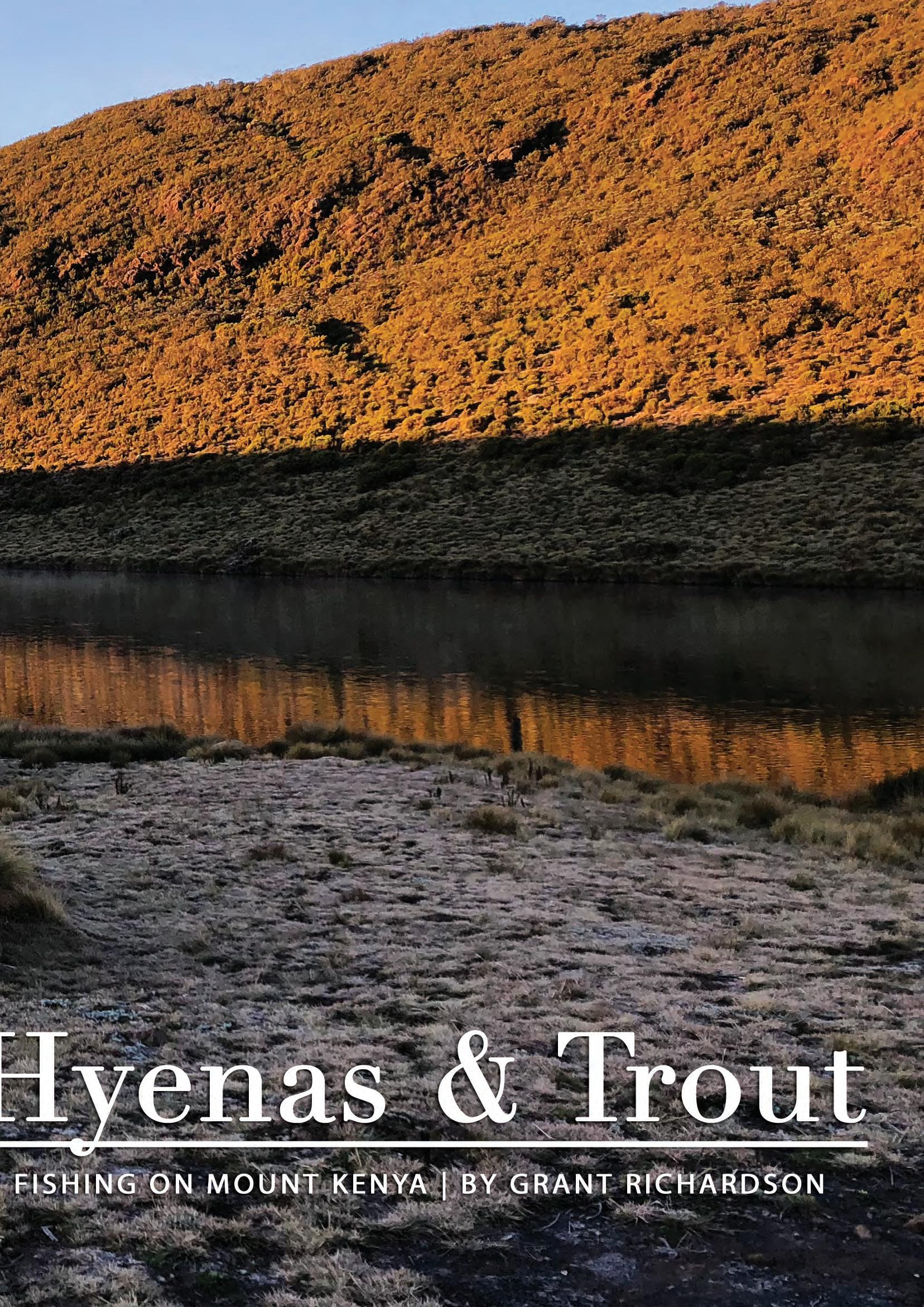
7 minute read
Fishing on Mount Kenya
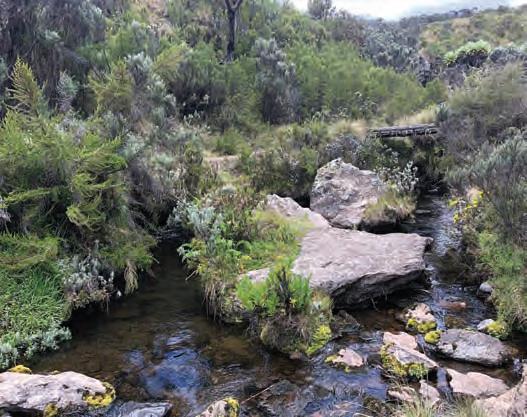
IREGULARLY heard stories from friends about how they pioneered the current flyfishing trips into the depths of Lesotho or guided clients between elephants in the Okavango for tigerfish. As I heard their stories, in the back of my mind I would always hope that one day I would experience something similar to their adventures. Getting funny rashes after wading around the Vaal definitely does not count as an adventure! Nor does getting dumped in the surf by a rogue wave on the north coast make for great stories.
Advertisement
Thanks to my chosen profession I frequently have to travel around South Africa and up into Africa, and Kenya was next on the list. This was it — a chance to have my own experience!
The author with a beauty. After a few days of perusing Google for possible flyfishing excursions, I came across a company that specialised in hiking on Mount Kenya and also included a flyfishing package for targeting trout in the lakes and streams dotted around the mountain slopes. I got in contact with them and started planning the tour.
My dates were in the beginning of September, in the middle of their dry season, which was perfect. The company director decided to plan my itinerary around hitting the two main lakes, namely Lake Ellis and Lake Michaelson, and the upper Nithi River in the Hinde Gorge. The lakes have been stocked with rainbows which sport the famous high altitude reddish-pink markings, while the streams have been stocked with browns.
I landed in Nairobi’s Jomo Kenyatta International Airport where a driver was ready to pick me up, and we began the four hour, 210km drive to Chogoria Park Gate (2 950m above sea level). I was greeted by my guide, Jacob, andhis team of porters, and we had a quick lunch before starting the adventure. The first day’s hike was subdued — about 40 minutes with a visit to the park’s trout farm which stocks the surrounding area.
The buildings and concrete dams are run down with little maintenance having been done and most repairs look improvised. The caretaker explained to me that the project had suffered in the past from a lack of funding, but that had

changed this year and they were able to restart the breeding program.
As we left the trout farm we walked past a small stream that supplies water for the trout farm and Jacob asked if I wanted a quick fishing session before we headed for our first camp site. The stream was barely a metre wide and a foot deep, with crystal clear water at the bottom of a steep bank. As I peered over the edge I could see a few baby browns scatter to hide below the overhanging bushes. This was going to be challenging! I set up my Sage ESN 3-wt, attached a long leader with 6X tippet and tied on a small dry-dropper combo at the end of it. Crouching behind the bushes trying not to be seen, my first go produced nothing. Second go and I open the account with a beautiful baby brown. I took a quick picture and released the fish. After about 20 more minutes of trying to coax them out, with only one selfreleased fish, Jacob explained that we’d better get going to our camp site before it got dark,as this was a wild life park and predators come out at night.
Jacob was not fibbing about the predators. That night the battle between the hyenas roaming around the camp site and my urge to use the toilet raged strong. Bladder control won. After a hearty breakfast — and a long period standing behind a tree — we proceeded on the two hour hike to Lake Ellis (3 400m above sea level).
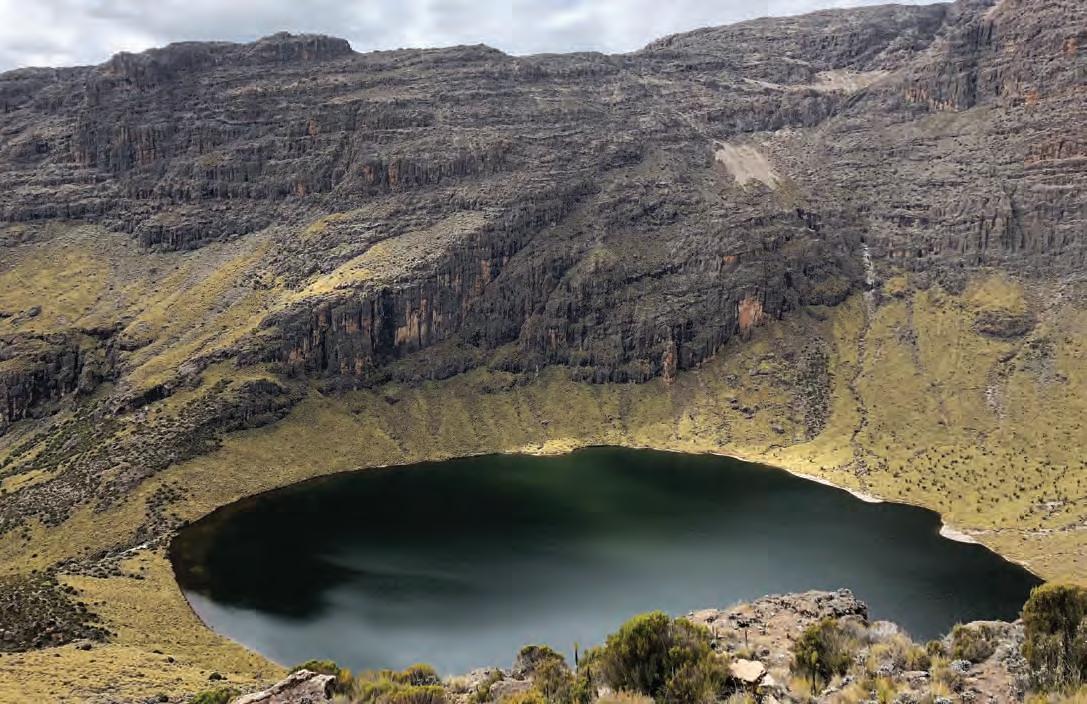
Small stream heaven.

Looking down on Lake Michaelson.
When we reached the lake I spotted an absolute submarine of a rainbow cruising about 30m out from the shore. I thought to myself that a 6-wt was not going to cut it if I hooked into that beast!
We decided that I would first hit the upper Nithi and then come back for the evening hatch on Lake Ellis.
It was a three kilometre hike to a pristine section on the Nithi. The river, actually more of a stream, was about two metres wide and about two feet deep in the pools, with bushy clumps of grass between large boulders on the banks. The pools were littered with skittish baby browns. I took advantage of the grassy banks and lobbed a size 16 Parachute Adams into the start
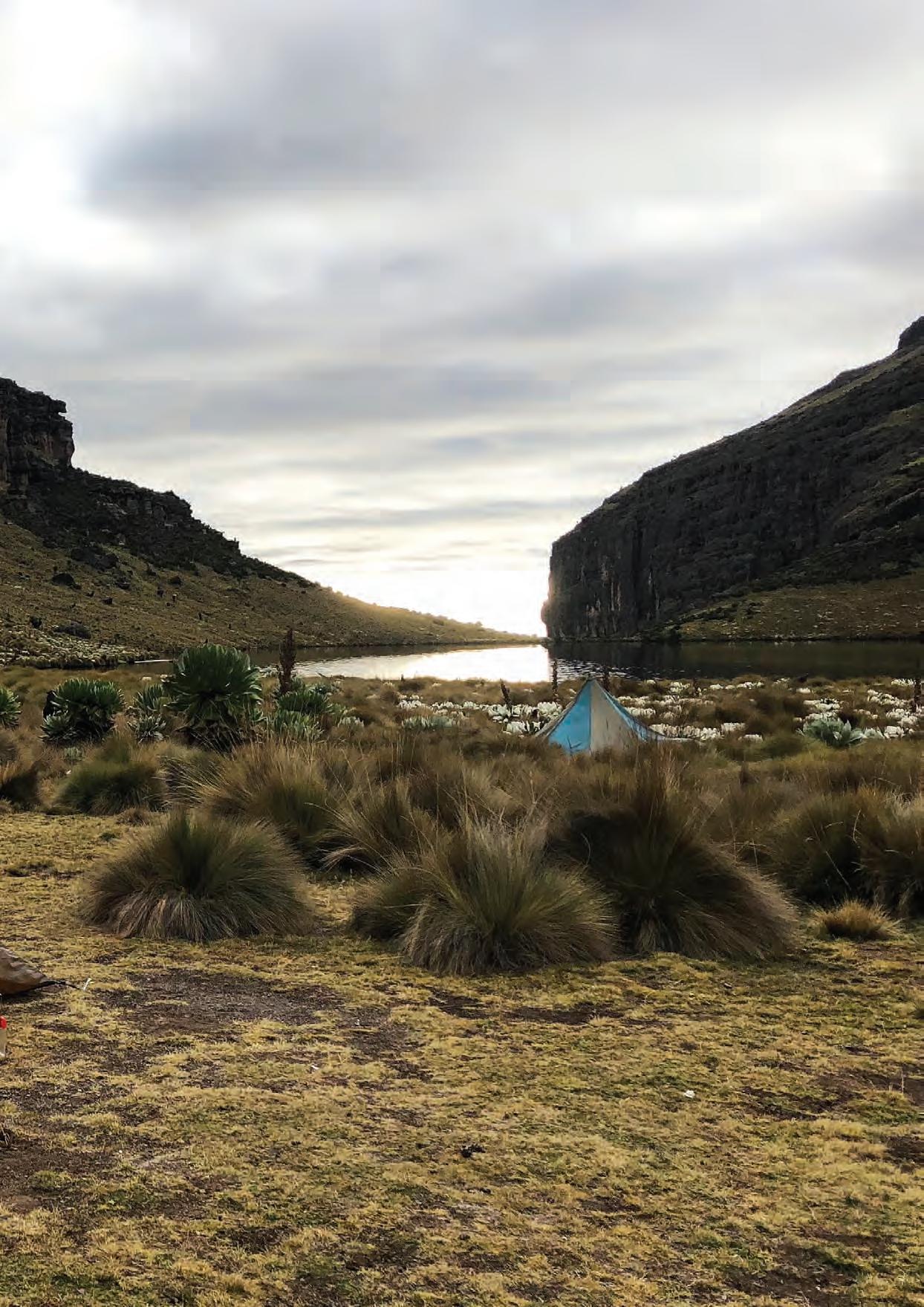
of the pool, progressively working my way upstream, pool by pool.
After two hours I had lost count of the browns I had caught, to the point that it was getting ridiculous. The last pool I fished I took nine baby browns out on 15 casts before they wised up. The largest brown for the session was approximately 25cm in length. With hindsight, my 3-wt was overkill.
Unfortunately, the success I had on the Nithi was not reciprocated on Lake Ellis. Due to porters unashamedly taking fish out for food, the few survivors have learnt to stay in the middle of the lake, out of casting reach. Unless you take an inflatable with you, Lake Ellis will most likely result in a blank.
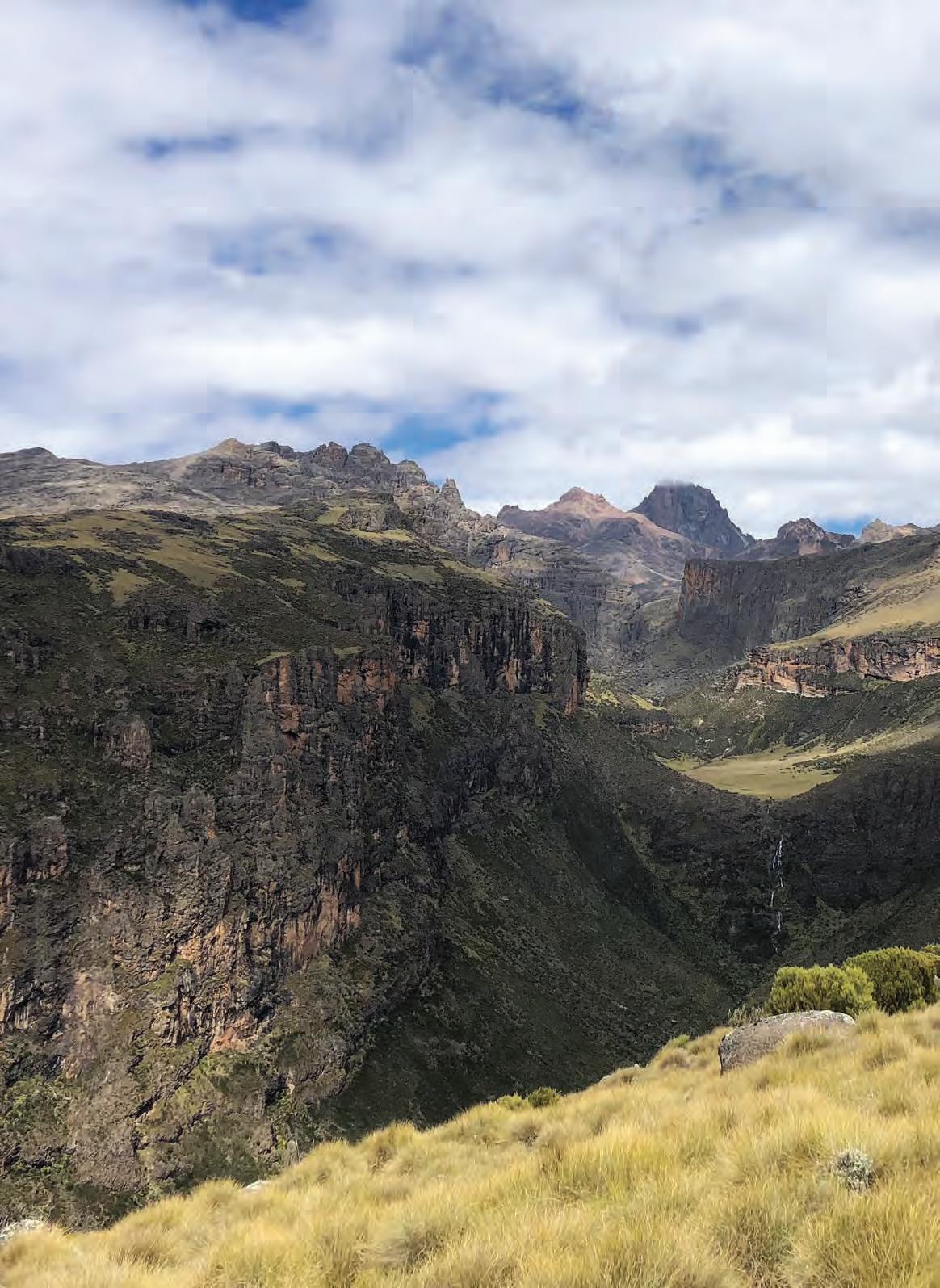
Join us on Facebook The following day was a tough one. The icy cold morning began with a six-hour hike to Lake Michaelson, ascending to approximately 4 300m above sea level, before making the steep 300m descent down into the glacial eroded valley. Lake Michaelson is by far the most visually impressive lake on Mount Kenya. While the porters set up camp I started setting up my rods and planning the afternoon’s strategy while sipping on a cup of Kenyan tea. The lake is estimated to be more than 70m deep, and my first plan of attack was to work around the point where a glacial stream feeds into the lake, using my Sage VXP 6-wt with a Di-5 line and big, black, beaded bugger.
After half an hour of no luck, trying every possible retrieve, I decided to change tactics. I noticed that numerous fingerlings were hugging the shore line, a good sign of a healthy breeding population of rainbows. With that in mind I decided to rather concentrate closer to shore as the lake bottom was visible for the first two metres and thereafter it dropped straight down.
Since a 6-wt would not have been practical for close combat, I swopped over to my 3-wt and a UV orange hot spot Frenchie. Making no more than five-metre casts out, just beyond the ledge, allowing the Frenchie to sink, slowly lifting the rod up and allowing for a long hang produced a lot more interest from the local residents. I was rewarded with two beautiful rainbows which were kept for the porters and had numerous offs as well. After the early afternoon session and another cup of tea I decided to carry on using the Frenchie, but this time on my 6-wt to cover a larger area. The late afternoon session, and my last session for the tour, only produced one baby rainbow. The highlight was hooking into something that was powerful enough to put a proper bend in the 6-wt and which peeled off a few metres of line before I even knew what was going on. Unfortunately, I never saw the size, although I am sure in the years to come said rainbow will likely increase to submarine status.
The next morning we proceeded on the six-hour 20km hike back to Chogoria Park Gate where I would spend the night in the rather rustic bandas. The concerning part was the number of fresh leopard and hyena tracks and scat on the first section of the path. Just to give myself a bit of street cred I kicked some scat off the path and thought to myself, “Yeah, I’m a mountain man!”
Our lunchtime break was on the banks of the Nithi River just before it enters the forest section of the park. While I sat and enjoyed a sandwich, I was able to observe the baby browns in the river as they gently rose up to sip floating insects off the surface. A most fitting end to an incredible adventure.




